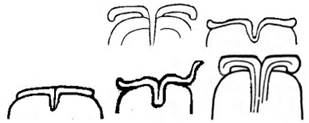![]()
![]()
![]()
K&L.p38.#9.1 TOK.p15.r3.c4 BMM9.p10.r6.c4 25EMC.pdfp44.#5.1&2 = K&L.p38.#9.2&2
PA’ PA’ PA’
![]()
![]()
MC.p159.c2.r1.3 0299st
PA PA’

![]()
![]()
K&L.p38.#9.2-6 MHD.2S7.1&2&3 0299ex
PA’ PA’ / pa PA’
· No glyphs given in K&H.
· Boot-T299 is the paper which proposes and demonstrates that T299 is the logogram PA’, based on substitutions of this glyph with pa-a.
· Variants (2):
o A. Stand-alone variant: basically a boulder outline with a split in the middle of the top, reaching in to anywhere from halfway down to the very bottom of the glyph.
o B. Attached / feeler variant: two feelers – left and right – which emerge while going upwards from a central point somewhere inside another glyph.
· Meaning:
o EB.p144.pdfp149.#2: stream, creek, arroyo.
o K&H.p114.#3: ravine, canyon, cleft.
o 25EMC.pdfp44.#5: ravine, canyon, cleft, split.
· Martin-BS.p4.c2.fn9: Pa’ has more than one sense in Mayan languages, and as a noun can describe an enclosing wall or fortress, or a bank of earth, such as one might find on a riverbank. Sim: perhaps “split” è “split in earth caused by river” è “riverbank” è “wall” è “fortress”.
· Do not confuse the “feeler” variant of this with one of the less common variants of SIH = “to be born”. Both are two “leaves” or “feelers” emerging upwards from the central point of a boulder-outline. But the two mirror-image elements of SIH tend to be broader and more leaf-like, while the two mirror-image elements of PA’ tend to be thinner and more feeler-like.